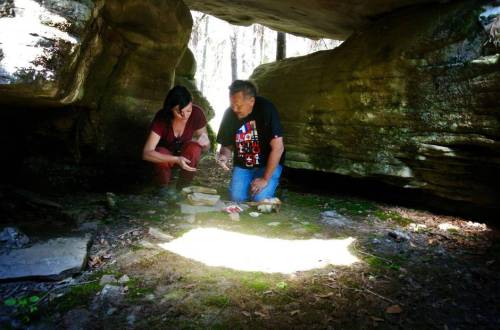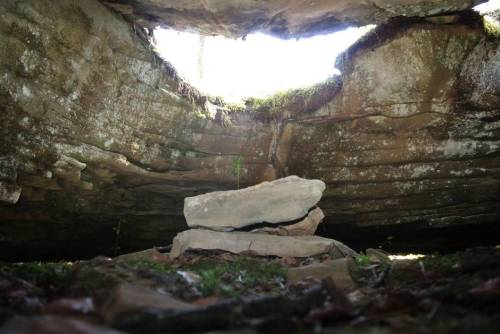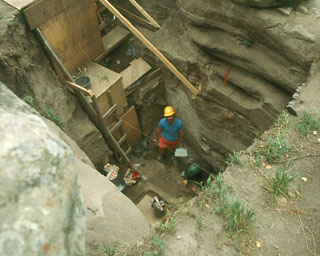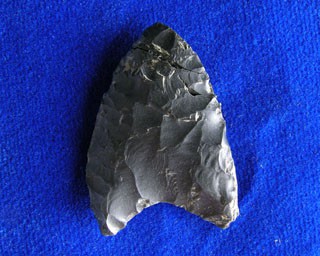
Inside of Cave near Tumbler Ridge with members of Saulteau First Nation. Source: Mark Hume, Globe and Mail.
Tumbler Ridge is a small coal-mining town on the eastern flanks of the Rockies, where British Columbia starts to resemble Alberta. It’s not a million miles, in distance nor in generalized setting, from Fort St. John (map), where Charlie Lake Cave remains one of BC’s most significant archaeological sites. Charlie Lake Cave has radiocarbon dates of up to 10,500 years old (PDF), or possibly as old as 12,750 calendrical years or thereabouts. With interesting finds such as a basally-thinned projectile point reminiscent of a fluted point, and the deliberate burial of two ravens from the lower layers (PDF), combined with it’s location in the “ice free corridor” has made this site really significant for regional cultural history (PDF) as well as for larger issues in the peopling of the Americas debate. (And see the new introduction/context to the Raven paper by Driver here). The Cave was recently purchased by local First Nations, which is an interesting development with the goal of protection and developing a cultural tourism site.
Anyway, this post is not actually about Charlie Lake Cave, just to introduce the archaeological potential of caves in this general part of the province, a potential that is not really been realized yet. It’s cool then to see pictures of a newly discovered cave with some superficial archaeological findings near Tumbler Ridge, as pictured above and outlined in this good article by Mark Hume in the Globe and Mail.
OK, so clearly nothing is proven yet. The piled rocks to my eyes do look kind of recent. They could be prospectors messing around, or they could be part of a spiritual practice. This cave needs to be treated with respect. The really old layers could easily be many metres down, if it was occupied early. The cave is in good archaeological hands though, with Charlie Lake cave spearhead Dr. Jon Driver (SFU) and friend of this Blog Rémi Farvacque of Archer CRM, involved.
As far as I can tell from the article, some flakes were found near the entrance to the cave, but not actually in it. Most likely this stems from the visit not being under permit and so actual digging or even probing around was likely not allowed (knowledgeable readers can correct me on this), and rightly so. Apparently burnt bone was also found. It seems very likely such a large, airy and dry cave was used over the millennia – though at Charlie Lake the deepest layers excavated were actually just outside the entrance.
It sounds like the Saulteau members who visited the site were generally positive about the potential for research: Karen Aird, the cultural resource adviser, suggesting she would take it up with Council and may then look for a University partner.
Finally, shout-out to local paleontologist Dr Charles Helm (Tumbler Ridge is actually well known for dinosaurs and whatnot) who found (re-found) the cave and appears to be guarding its location carefully. Hopefully it turns into a cool project but even if not then this cave looks like a special place for all concerned.





I’ve been to Tumbler Ridge, and I quite liked it. It’s beautiful, like the Rocky Mountains with none of the tourists. It’s a little hard to get to for us southerners.
I went to attend something called the “Coal Forum.” The turncoat co-founder of Greenpeace presented.
LikeLike
Hi Nevin. It’s a place I’ve never been but I think there is at least one prominent West Coast Archaeologist with roots there. Not going to out him/her though.
It’s hard to understand what went wrong with Patrick Moore and how he sleeps at night. http://www.greenpeace.org/usa/news/greenpeace-statement-on-patric/
LikeLike
Great write-up.
Does anyone have dimensions on the concave base projectile? There is no scale…
LikeLike
Hi JGarrett, thanks for your comment. To be clear, that projectile point is from Charlie Lake Cave, not the “new” Tumbler Ridge one. Here is a fairly poor scan of the point with a scale. As you can see, it is fairly small. This is from the Fladmark overview linked above, it’s a PDF.
Click to access 11UBC2_OCRed.pdf
LikeLike
Thanks for the reply. I see in the paper it is 28.4 mm wide and thickness is 5.6 mm. It has a striking similarity to Clovis-like points I’ve studied from further south in the Great Basin.
LikeLike
Hi again, yeah I think in earlier Charlie Lake publications it may have been called a Clovis point (of the worn out variety), but kind of recent for Clovis, and not a great exemplar. I think more recent pubs refer to it as a fluted point or, as here, “basally thinned”.
If you’re interested in the broader context, there’s a good, recent review of the Ice Free Corridor here, in the volume PaleoAmerican Odyssey
https://catalog.libraries.wm.edu/Record/4120992/TOC
Chapter (not downloadable as far as I know) in question is:
Vectors, vestiges, and Valhallas: rethinking the corridor / John W. Ives, Duane Froese, Kisha Supernant, and Gabriel Yanicki
LikeLike
The cave floor is very flat – great for occupation. But I wonder how deep the sediments can be – it looks like horizontally-bedded sandstone on the walls, and perhaps the floor is bedrock not far down? I’ll be really interested to hear more! I gather from the article that the burnt bones and flake were in/near a different rockshelter than these photos. Cave sites are so very, very special!
LikeLike
Hi Morley. I’ve never been to either of these, but the cave itself seems broadly similar to pictures of Charlie Lake cave. As in that case, there may be significant deposits outside the cave proper. I agree that it may not be too deep on the inside, on the upside, maybe there’s less far to go to get to the bottom eh?
In this picture CLC has been recently vandalized, though I understand it has been purchase by the FN in the goal of making it a heritage destination.Anyway, it shows bedded sandstone per the Tumbler Ridge appearance.
See also

and
LikeLike
I almost saw Charlie Lake before it was excavated. I was on my way to visit the CLC on the recommendation of our boatman in 1980(?) who lived on the lakeshore on the adjacent property. Local settler kids had had decades of hanging out in the cave and I think even doing some minor digging at that time. I was diverted by a float plane crashing into trees, just missing a house. I was the first on the scene, tried to get the injured pilot and passenger to sit down instead of stumbling randomly and did a rapid assessment, but also had to get into the house and get out the two small kids who had been left alone watching TV while parent did an errand. The plane was belching rivers of burning avgas by that point which started a nice crackling forest fire around the house. I was very glad to have watertrucks and firetrucks get there a few minutes later! But I never got to see the cave….
LikeLike
That story escalated quickly, Morley.
LikeLike
Interesting find. The entire Northern Rockies and Mackenzies are riddled with caves and I have heard of a very large one south of the Liard with pictos etc. in it. When flying the Alaska Highway Pipeline a few yrs ago saw a number south of the Liard some like further south on the beach lines of the glacial lakes.
>
LikeLike
Hello from Tumbler Ridge! This blog post just popped up on my timeline, and I thought I would share some insight from the Tumbler Ridge UNESCO Global Geopark manager, and resident archaeologist. On the day of the site visit, I had a newborn baby and could not attend. Alas, so much has been said and done since, I wish I was there. To answer some speculation: the location of the cave is across a noteworthy river from most roads and trails, so it is likely that the stone cairn is older, although the river is popular with jet boaters. It’s a steep climb up to this area. The lack of any lichen development has been attributed to its location away from sunlight and direct moisture, and there is almost no deposition to be excavated. There was no permit for the site visit, and the flakes were surface observations, left in situ. I have plans to go back as a part of a bigger Geopark research permit, and will certainly post here if we do. There is another site of great interest nearby and I am keen to see if the calcined bone I found leads to potential hearth features, so rare in the NE.
LikeLike